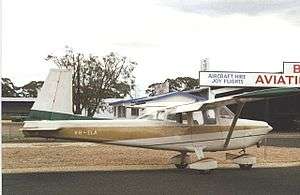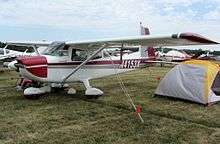Aero Commander 100
The Aero Commander 100, various models of which were known as the Darter Commander and Lark Commander was a US light aircraft produced in the 1960s. It was a high-wing monoplane of conventional design, equipped with fixed tricycle undercarriage.
| Aero Commander 100/Darter Commander | |
|---|---|
 | |
| Aero Commander 100 at Bendigo, Victoria, Australia in March 1988 | |
| Role | Light aircraft |
| National origin | United States of America |
| Manufacturer | Volaircraft/Aero Commander |
| First flight | 1960 |
The aircraft was originally designed by Volaircraft, first flying in 1960. The firm marketed the original three-seat version as the Volaire 1035 and a four-seat version with a more powerful engine as the Volaire 1050 before North American Rockwell purchased all rights to the design on July 12, 1965, for production by its Aero Commander division. Production of the Darter Commander version continued until 1969 and of the revised Lark Commander until 1971 (by which time, Rockwell had dropped the Aero Commander brand name).
A Volaire 1050 was exhibited at the 1966 Hanover Air Show and later sold to Finland. Other examples of the type were exported to Australia and Canada.
Finding the light aircraft market too competitive for its liking, Rockwell ceased production of the Lark Commander in 1971 and sold the rights to all versions of the aircraft to Phoenix Aircraft of Euclid, Ohio,[1] but this company never actually put it into production.
Variants
Volaircraft
- Model 10 – prototypes
- Volaire 1035 – three-seat production version powered by Lycoming O-290
- Volaire 1050 – four-seat production version powered by Lycoming O-320
Aero Commander/Rockwell

- Aero Commander 100 – alias Volaire 1050
- Aero Commander 100A – alias Volaire 1035
- Darter Commander – 100 with revised windows and other minor modifications
- Lark Commander 180 – revised aerodynamics, with swept fin and rudder and 180 hp (130 kW) Lycoming O-360-A2F engine. Production from 1968.[2]
Specifications (Darter Commander)
Data from Jane's All The World's Aircraft 1969–70 [3]
General characteristics
- Crew: 1
- Capacity: 3 passengers
- Length: 22 ft 6 in (6.86 m)
- Wingspan: 35 ft 0 in (10.67 m)
- Height: 9 ft 4 in (2.84 m)
- Wing area: 181 sq ft (16.8 m2)
- Empty weight: 1,280 lb (581 kg)
- Max takeoff weight: 2,250 lb (1,021 kg)
- Fuel capacity: 44 US Gallons (166.5 L)
- Powerplant: 1 × Lycoming O-320-A air-cooled flat-four, 150 hp (110 kW)
Performance
- Maximum speed: 133 mph (214 km/h, 116 kn)
- Cruise speed: 128 mph (206 km/h, 111 kn) at 7,500 ft (2,285 m) (75% power)
- Stall speed: 55 mph (89 km/h, 48 kn) flaps down
- Never exceed speed: 170 mph (270 km/h, 150 kn)
- Range: 510 mi (820 km, 440 nmi)
- Service ceiling: 13,000 ft (4,000 m)
- Rate of climb: 785 ft/min (3.99 m/s)
References
- "Private Flying: Aero Commander designs sold". Flight International. Vol. 100 no. 3275. December 16, 1971. p. 971. Retrieved November 16, 2019.
- Taylor 1971, p. 366.
- Taylor 1969, p.398
- Taylor, John W. R. Jane's All The World's Aircraft 1969–70. London:Jane's Yearbooks, 1969.
- Taylor, John W. R., ed. (1971). Jane's All the World's Aircraft 1971–72. London: Sampson Low, Marston & Co., Ltd. ISBN 0-354-00094-2.CS1 maint: ref=harv (link)
External links
![]()